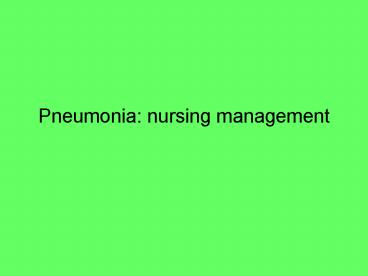Pneumonia: nursing management - PowerPoint PPT Presentation
1 / 10
Title:
Pneumonia: nursing management
Description:
Pneumonia: nursing management Definition Pneumonia is a pulmonary infection with inflammation that develops after someone inhales airborne pathogens or aspirates ... – PowerPoint PPT presentation
Number of Views:4704
Avg rating:3.0/5.0
Title: Pneumonia: nursing management
1
Pneumonia nursing management
2
Definition
- Pneumonia is a pulmonary infection with
inflammation that develops after someone inhales
airborne pathogens or aspirates pathogens in
secretions from the upper respiratory or
gastrointestinal tract.
3
Classification
- bacterial
- viral
- fungal
- Depending on the patient's clinical and X-ray
findings, pneumonia is further classified as
lobar pneumonia (affecting one or more lobes),
bronchopneumonia (affecting the terminal
bronchial tree, distal airways, and alveoli), or
inflammation of the interstitial space.
4
- Community-acquired pneumonia is pneumonia that
someone contracts outside the hospital setting.
In many cases, a respiratory virus, such as
influenza or adenovirus, is the infectious
organism. The most common bacterial cause is
Gram-positive Streptococcus pneumoniae. - Nosocomial (hospital-acquired) pneumonia
develops more than 7 days after hospital
admission. It's likely to be caused by different
pathogens, including Staphylococcus aureus and
Klebsiella.
5
Risk factors for CAP
- a. Elderly
- b. Very young
- c. Cystic fibrosis
- d. Respiratory conditions
- e. Smoking
- f. Immunocomprompromised
- g. Heart disease
- h. Diabetes
6
Signs and symptoms
- a. Cough
- b. Sputum
- c. Dyspnea
- d. Pleuritic chest pain
- e. Crackles (auscultation)
- f. Dullness (percussion)
- g. Fever or hypothermia
- h. Low or high WBC count
7
Less common signs and symptoms
- a. Increased heart rate
- b. Cyanosis
- c. Retractions (infants and children)
- d. Lung secretions
- e. Dehydration
- f. Anorexia
- g. Behavior changes
8
X-ray findings
- a. Viral
- b. Bacterial
- c. Uncommon organism
9
Treatment
- 1. Antibiotic therapy if applicable
- 2. Maintain oxygenation
- 3. Maintain airway clearance
- 4. Maintain adequate hydration
- 5. Monitor temperature
10
Patient education
- 1. Hand hygiene
- 2. Asthma control
- 3. Yearly flu immunization































